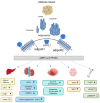The Role of Adipose Tissue and Nutrition in the Regulation of Adiponectin
- PMID: 39125318
- PMCID: PMC11313710
- DOI: 10.3390/nu16152436
The Role of Adipose Tissue and Nutrition in the Regulation of Adiponectin
Abstract
Adipose tissue (AT), composed mainly of adipocytes, plays a critical role in lipid control, metabolism, and energy storage. Once considered metabolically inert, AT is now recognized as a dynamic endocrine organ that regulates food intake, energy homeostasis, insulin sensitivity, thermoregulation, and immune responses. This review examines the multifaceted role of adiponectin, a predominant adipokine released by AT, in glucose and fatty acid metabolism. We explore the regulatory mechanisms of adiponectin, its physiological effects and its potential as a therapeutic target for metabolic diseases such as type 2 diabetes, cardiovascular disease and fatty liver disease. Furthermore, we analyze the impact of various dietary patterns, specific nutrients, and physical activities on adiponectin levels, highlighting strategies to improve metabolic health. Our comprehensive review provides insights into the critical functions of adiponectin and its importance in maintaining systemic metabolic homeostasis.
Keywords: adipokines; adiponectin; adipose tissue; cardiovascular disease; dietary interventions; endocrine function; fatty acid metabolism; insulin sensitivity; metabolic diseases; metabolic homeostasis; nutritional therapy; physical activity; type 2 diabetes.
Conflict of interest statement
The authors declare no conflicts of interest.
Figures


References
Publication types
MeSH terms
Substances
LinkOut - more resources
Full Text Sources

